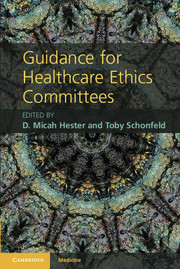Book contents
- Frontmatter
- Contents
- Contributors
- Preface
- Section 1 The Context of Healthcare Ethics Committee Work
- Section 2 Consultation
- Section 3 Policy Development and Organizational Issues
- Section 4 Educating Others
- 20 The healthcare ethics committee as educator
- 21 Education as prevention
- 22 Understanding ethics pedagogy
- Index
- References
22 - Understanding ethics pedagogy
Published online by Cambridge University Press: 05 August 2012
- Frontmatter
- Contents
- Contributors
- Preface
- Section 1 The Context of Healthcare Ethics Committee Work
- Section 2 Consultation
- Section 3 Policy Development and Organizational Issues
- Section 4 Educating Others
- 20 The healthcare ethics committee as educator
- 21 Education as prevention
- 22 Understanding ethics pedagogy
- Index
- References
Summary
Objectives
Identify the ways instruction about ethics is diferent from instruction about other topics.
Describe common barriers to teaching ethics.
Describe important educational objectives for ethics and the teaching strategies that facilitate them.
Case
Mary Rivera, 82, was admitted to the hospitalwith shortness of breath, diarrhea,weakness, and near syncope. She has a history of Alzheimer’s Disease, diabetes, hypertension, chronic aspiration, and multiple episodes of pneumonia. She is again diagnosed with aspiration pneumonia. On admission, she is awake and oriented, requests treatment to “help her breathe” and notes she has an advance directive on file. Subsequently, her cognition declines. Her kidneys begin to fail and recovery is considered unlikely.
Mary was widowed years before and has seven adult children, all of whom regularly visit her in the hospital. Her youngest son, Jimmy, 43, has continued to live with her since childhood. Jimmy is a large man who previously worked part time as a bouncer at a local night club, but claims he quit his job to stay home to care for his mother. His demeanor is intimidating and the unit nurses often call security when he visits. He presents an advance directive Mary prepared 8 years prior that names him as durable power of attorney (DPOA) and expresses a preference for continued treatment. He states Mary had told him repeatedly to fight for her. The advance directive in the chart is more recent, dated 3 years ago, and names Mary’s eldest daughter, Emily, as DPOA, and states a preference to forgo life-sustaining treatment in the event that her condition is irreversible and incurable. Emily is a quiet woman, married with four children, and works as an accountant. Brother and sister have been at odds regarding their mother’s treatment and the other siblings have taken sides. At medical issue is Mary’s code status and continuation of ventilator support. Socially, the siblings report that Jimmy is living on Mary’s social security and wants to continue treatment to maintain his source of income. Emily believes their mother is suffering and that treatment is contrary to Mary’s wishes.
- Type
- Chapter
- Information
- Guidance for Healthcare Ethics Committees , pp. 172 - 179Publisher: Cambridge University PressPrint publication year: 2012

